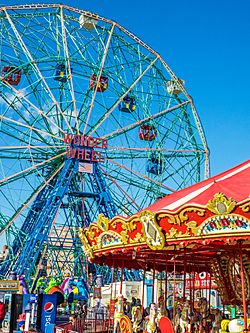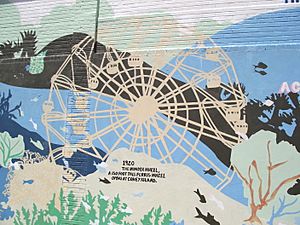Wonder Wheel facts for kids
Quick facts for kids Wonder Wheel |
|||||||||||||||||
|---|---|---|---|---|---|---|---|---|---|---|---|---|---|---|---|---|---|

Seen in 2019
|
|||||||||||||||||
|
|||||||||||||||||
| Ride statistics | |||||||||||||||||
| Attraction type | Ferris wheel | ||||||||||||||||
| Manufacturer | Eccentric Ferris Wheel Company | ||||||||||||||||
| Model | Eccentric wheel | ||||||||||||||||
| Height | 150 ft (46 m) | ||||||||||||||||
| Vehicle type | Gondola | ||||||||||||||||
| Vehicles | 24 | ||||||||||||||||
| Riders per vehicle | 6 | ||||||||||||||||
The Wonder Wheel is a famous Ferris wheel located at Deno's Wonder Wheel Amusement Park in Coney Island, New York City. It stands 150-foot-tall (46 m), which is about as high as a 15-story building! What makes it special is that some of its passenger cars don't just stay in one spot. Instead, they slide along winding tracks as the wheel turns. This gives riders an extra thrill!
The Wonder Wheel was built in 1920. It was designed by Charles Hermann. Herman J. Garms Sr. operated it for 60 years. Even when Coney Island faced tough times, the Wonder Wheel kept running every summer. In 1983, the Vourderis family bought the ride. They fixed it up and still run it today. The New York City Landmarks Preservation Commission made the Wonder Wheel an official New York City landmark in 1989.
Contents
History of the Wonder Wheel
When the Wonder Wheel was built, Coney Island was one of the biggest amusement areas in the United States. Many different kinds of Ferris wheels were built there in the early 1900s. The Wonder Wheel was unique. Only one-third of its 24 cars stayed still. The other two-thirds rolled on tracks inside the wheel itself.
Garms Family Ownership

Charles Hermann designed the Wonder Wheel. He wanted to make a better version of the original Ferris wheel. The Eccentric Ferris Wheel Company built it between 1918 and 1920. Herman J. Garms Sr. was the first owner. He even lived under the Wonder Wheel during the summers to help keep it in good shape!
The wheel opened on Memorial Day in 1920. Hermann first called it the "Dip-the-Dip." He said it would combine the fun of a roller coaster, a Ferris wheel, and a water slide. An article from that time said the Wonder Wheel gave a "real thrill." It was later called the "Eccentric Ferris Wheel." By 1940, it was known as the "Wonder Wheel."
By the 1960s, Herman Garms's son, Fred Garms, took over running the Wonder Wheel. Coney Island started to have fewer visitors. But the Wonder Wheel kept going strong. It had a great safety record. To keep the area safe at night, two German Shepherd dogs guarded the wheel. During the day, the dogs even rode in one of the Wonder Wheel's cars!
Vourderis Family Ownership
Fred Garms wanted to sell the wheel by 1983. He was getting older and found it hard to manage. Deno D. Vourderis had always wanted to buy the wheel. On June 7, 1983, Deno Vourderis bought the Wonder Wheel. It then became part of "Deno's Wonder Wheel Amusement Park."
The Vourderis family spent a lot of money to fix up the wheel. Deno Vourderis said he wanted to give the wheel to his wife, Lula. He had proposed to her on top of the wheel 36 years before!
In 1989, the Wonder Wheel became a New York City landmark. This means it's a special historical place. When Deno passed away in the mid-1990s, his son Dennis Vourderis took over. In the 2000s, Deno's grandchildren also started helping. The Wonder Wheel and its park are still family-operated.
In 2012, the Wonder Wheel got a new solar-powered lighting system. This replaced an old system that had been broken for 30 years. Even after Hurricane Sandy hit in 2012, the Wonder Wheel was only slightly damaged. It reopened the next year.
As of 2020, the Wonder Wheel is the oldest ride that has continuously operated at Coney Island. Dennis Vourderis and his brother Steve still run it. The Vourderis family had planned a big party for the Wonder Wheel's 100th birthday in May 2020. But this was postponed because of the COVID-19 pandemic in New York City.
What Makes the Wonder Wheel Special?
Wheel Design and Features
The Wonder Wheel is located at 3059 West 12th Street. It has a large, bright sign that says "WONDER WHEEL" in orange letters. The wheel has 16 spokes that connect to an outer frame. The frame is shaped like a 16-sided polygon.
The wheel is 150 feet (46 m) tall. It weighs 200 short tons (180 long tons), which is like 200 small cars! A 40 horsepower (30 kW) motor powers it. The Wonder Wheel has 24 passenger cars. Each car can hold six people. This means 144 people can ride at once.
Eight of the cars are fixed to the rim, like a regular Ferris wheel. But 16 of the cars slide inward on winding tracks. They fall outward as the wheel spins. This gives riders a unique and exciting experience!
Riding the Wonder Wheel
There is no height limit to ride the Wonder Wheel. In 2015, a newspaper estimated that 200,000 people ride it every year. By 2018, over 35 million rides had been taken on the wheel since it opened! You can choose to ride in a stationary car or a moving car. There are separate lines for each.
A ride on the Wonder Wheel costs 10 credits. Each ride goes around the wheel two times.
Safety First!
The Wonder Wheel has an excellent safety record. The former owner, Fred Garms, said he always put money into keeping it safe. News reports in 2000 said the Wonder Wheel had never had any major accidents. It has operated every summer since it opened. Even after Hurricane Sandy, the wheel was only slightly damaged.
The wheel was also built with an emergency hand crank. This allows workers to move the wheel and help passengers off if the power goes out. The owners always do maintenance on the wheel in the winter. This protects it from bad weather. The only time the wheel stopped without the operator's control was during a big power outage in New York City in 1977. But the owners used the hand crank to get everyone off safely.
The Wonder Wheel in Pop Culture
The New York Times called the Wonder Wheel "the jewel" of Coney Island. The Wonder Wheel has inspired at least two copies around the world. One is the Pixar Pal-A-Round at Disney California Adventure in California. It opened in 2001 and is also 150-foot-tall (46 m). There was also a copy in Yokohama Dreamland, Japan.
Because it's so famous, the Wonder Wheel has appeared in many movies and TV shows. These include the film The Warriors and the TV series Mr. Robot. A 2017 movie called Wonder Wheel was even named after it! The wheel has also been the place for many marriage proposals and weddings. In 2020, a historian named Charles Denson wrote a book about the Wonder Wheel called Coney Island’s Wonder Wheel Park.



